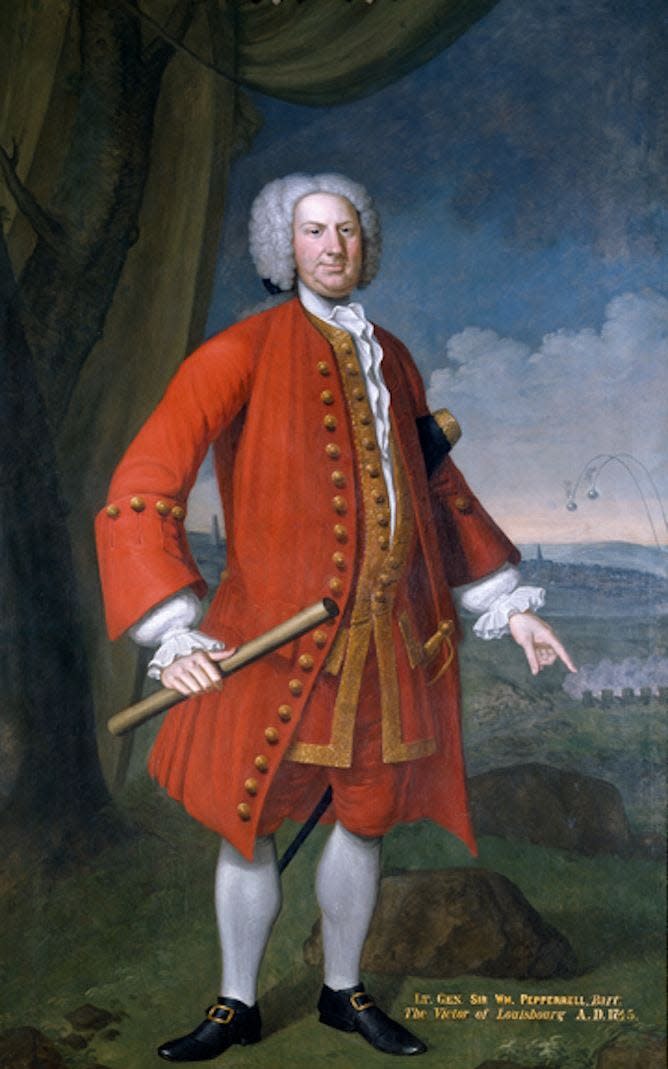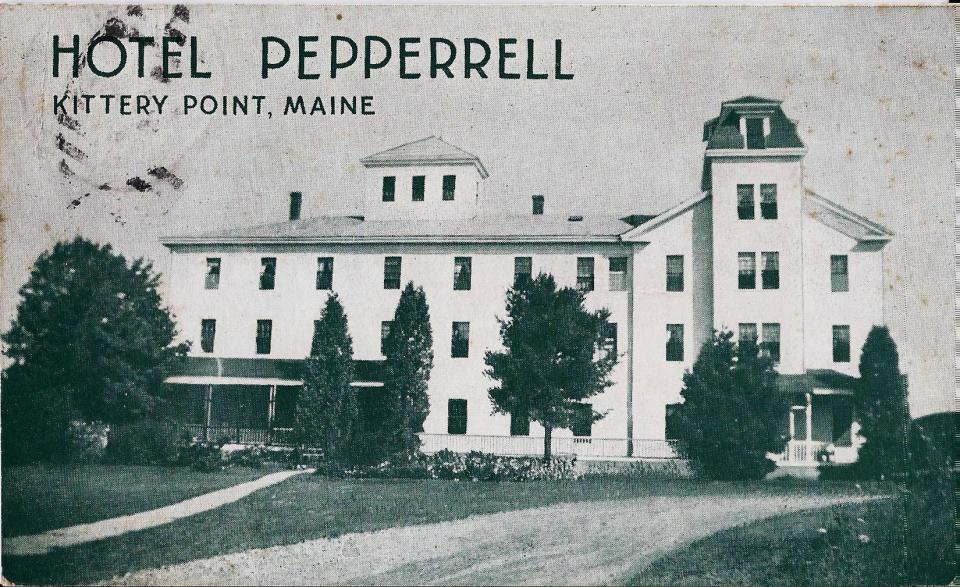The ‘Unvarnished Truth’ of Kittery’s Sir William Pepperrell's role in Kittery history

- Oops!Something went wrong.Please try again later.
This article is part of a monthly series celebrating Kittery’s history as Maine’s oldest town counts down to celebrate its 375th birthday.
Pepperrell Cove is one of Kittery’s best-known features, home to both the town pier and now a madly popular restaurant scene.
The adjacent William Pepperrell House, located on Pepperrell Road, is listed on the National Register of Historic Places. The once-glorious Hotel Pepperrell, at the opposite end of Pepperrell Terrace across the street from the cove, is today rented out to tenants. The Lady Pepperrell Mansion down the road may well be the town’s prize architectural jewel, and Pepperrell Green Professional Center is the site of a local business park on Route 1.
These sites are all linked to Sir William Pepperrell, who one could argue is the most prominent citizen in Kittery’s history – a statesman of immense wealth who became the most celebrated American military leader of the pre-Revolution 1700s. Kittery, and especially the area known as Kittery Point, was essentially his personal fiefdom – almost literally so, as his exploits brought him the distinction of being the first American-born colonist to be bestowed a baronet by the King of England.
Pepperrell is most commonly described as a merchant, but that doesn’t really give the full picture. It would be like calling Bill Gates an “I.T. guy.”
Pepperrell was said by some to be the richest man in America. It’s safe to say he was one of the richest. Legend tells us a traveler could journey from Kittery to Scarborough, Maine, a distance of about 40 miles, and not leave Pepperrell property. Another claims Pepperrell had a fleet of up to 100 vessels of various sizes, with the late author Neil Rolde suggesting Pepperrell actually owned 35 ships and then had shares in many others.
He was also the first American to be commissioned a lieutenant general in the British Army. Had he not died well before the Revolutionary War, there’s a strong likelihood Pepperrell would have remained a Loyalist during that conflict.
Even so, his mark still lies heavily on Maine’s oldest town, and beyond. Pepperrell, Massachusetts, located in Middlesex County, is named for Sir William. The city of Saco, Maine, was previously known as Pepperrellborough until the early 1800s.
Nathaniel Hawthorne, one of the great American authors of the 19th century, referred to Pepperrell as “the mighty man of Kittery” in a fawning 1833 essay celebrating his military victory at Louisburg, the feat for which Pepperrell is best known.
Like many wealthy Americans of his era, this lauded hero benefitted from the institution of slavery by owning fellow human beings who toiled for no pay. The Maine Historical Society describes Pepperrell as “Maine's most prolific and infamous slave owner.”
The local producers of a pending documentary about Pepperrell suggest he also profited from the slave trade.
“This started out to be a fairly mild documentary,” Kittery filmmaker Jim White said recently, “but now we see an opportunity to correct history.”
The working title of the documentary is “The Unvarnished Truth.”

The three William Pepperells
There are actually three William Pepperrells who figure prominently in Kittery’s history.
The first is typically referred to as Colonel Pepperrell to distinguish him from his son and great-grandson. He is the father of the Pepperrell line in America, immigrating here from Devonshire, England, as a simple fisherman in 1676. He was also founder of the far-reaching business empire which would make the family name so ubiquitous.
Initially setting up shop out at the Isles of Shoals, the elder Pepperrell began purchasing fishing vessels with a partner. He eventually made his way to Kittery Point and wed the daughter of John Bray, a wealthy local shipbuilder whose home still stands today and is considered one of the oldest structures in Maine (as well as the former residence of rock music icon Daryl Hall). Bray gifted the newlyweds with a neighboring acre of land, where Col. Pepperrell built the mansion which also still exists near the town wharf.
Pepperrell branched out significantly from that single acre over the years, essentially establishing himself as a land baron as well as a shipbuilder and merchant. He also became something of a town father in Kittery, serving as colonel of the local militia (hence the title for which he is best known), selectman, and justice of the peace, a post he held for 35 years, according to Rolde’s 1982 book “Sir William Pepperrell of Colonial New England." And it was the elder Pepperrell who first established the defense site we know today as Fort McClary.
The colonel died in 1734 at the ripe old age of 87.
His son – and the central character of this piece – is known to history as Sir William Pepperrell, to mark him from the others who share his name.
The third was actually born William Pepperrell Sparhawk, the grandson of Sir William. He was anointed successor of the Pepperrell dynasty on the condition of dropping his last name. This William Pepperrell remained a Tory during the American Revolution and wound up fleeing to England, leaving the family fortune behind.
But back to Sir William. Although perhaps Kittery’s most renowned resident, he was originally intended to be the “spare” rather than the family heir, as he had a much older brother named Andrew. As a result, not much is known of his early life.
Born in 1696, young William was 17 years old when his brother died at the age of 32 (Rolde p 19). As the only other son of the Pepperrell brood, which included six daughters, he was brought into the family business which became known as “The William Pepperrells.”
By all accounts, the younger Pepperrell greatly expanded this empire. He also served as a cavalry captain in the local militia before achieving the rank of colonel like his old man, and became justice of the peace like his father. He served locally as the town moderator, selectman, and member of the legislature in Massachusetts (as Maine was still a province of that colony).
But he then went on to serve as chief justice of the Court of Common Pleas, even though he had no formal legal training, and as the longtime president of the Massachusetts governor’s council. For years, it was he who kept the peace with neighboring Native American tribes as the area’s chief negotiator. For a few months in 1757, he even served as the acting governor.
Pepperrell’s single greatest shining moment, however, took place in 1745, when destiny placed him at the head of a ragtag American army to capture a fortress believed to be impregnable.
The King of France invested so many millions of francs in building up the defenses of Louisburg in Cape Breton, Nova Scotia, he reportedly said he expected to see it rising toward the heavens from his throne across the Atlantic. The French government spent two decades completing these fortifications.
The fort was called “the Gibraltar of the Atlantic,” and according to author Richard A. Brayall, was a source of great fear to colonists loyal to England.
“It was an awe-inspiring, frightening site to behold glowering over the sea routes to and from Europe,” Brayall wrote in his 2008 Pepperrell bio “To the Uttermost of My Power.” “Louisburg could and would threaten the lucrative fishing banks off the shore of Newfoundland.”
The fortress served as a vital French base of operations during King George’s War, one of a long-running series of conflicts between England, France, and various Native American tribes in region right up through the American Revolution. France had declared war on England in 1744, which extended across the ocean to this continent.
Louisburg posed such a threat to New Englanders, Massachusetts Gov. William Shirley developed what historians have referred to as “the mad scheme” to attack the fortress with an army of “farmers, mechanics, and fishermen.” And William Pepperrell was the man he asked to lead this army.
Although he had risen through the ranks to become colonel of the Maine militia, Pepperrell’s primary military experience had been as a teenage fort sentry in Kittery during Queen Anne’s War of the early 1700s, yet another of those struggles for control of America spun off from wars in Europe.
But Pepperrell was also extremely rich and extremely popular. He was the kind of leader other men would follow willingly into battle, and he had the financial resources to ensure they would be properly equipped. He also seemed to have a hand in just about every aspect of colonial life in the region.
“It is nearly impossible to imagine the influence William Pepperrell wielded in Massachusetts political, economic, judicial, military, social and religious circles,” Brayall noted in his book. “He never grabbed for power because somehow it was always handed to him.”
And so Pepperrell raised and trained a force of 4,500 men, and on March 29, 1745, as a newly commissioned lieutenant general, he and his army set out from Boston aboard 100 ships of various sizes to conquer the French. Four large British Royal Navy warships commanded by Commodore Peter Warren joined the fleet at Cape Breton.
Some historians have cited sheer luck as a major factor in Pepperrell’s ultimate victory at Louisburg. Luck was certainly in play shortly after the colonists landed, when a small party of 13 men came upon a key forward battery which the French had abandoned. The French soldiers, fearing a much larger attacking force, pulled out so hastily they failed to properly spike their guns, essentially handing over an additional 30 cannons to Pepperrell’s army.
But the true key to victory was the general’s decision to surround Louisburg with cannons and mortars. Part of the fort’s natural defense was the marshy, boggy area outside its walls. The common perception was that oxen and horses would not be able to drag heavy artillery over such swampland.
So Pepperrell directed his men to build wooden sledges which were used to pull the big guns by hand over the soft ground, by as many as 200 men at a time. It was slow, grueling labor, but eventually multiple batteries were erected around the fort, and the colonists proceeded to thoroughly bombard their French counterparts.
Meanwhile, additional British warships arrived to help maintain a blockade of the harbor, and captured French ships attempting to aid the fort.
The siege lasted exactly seven weeks. On June 15th, the very day Pepperrell and his officers had planned to launch a major assault on the fort, the French flew a white flag of truce to discuss surrender terms.
The victory at Louisburg made Pepperrell an international hero on both sides of the Atlantic. Church bells rang throughout New England in celebration of the news, and when he eventually returned to Boston, Pepperrell was a welcomed as a conquering victor.
During a subsequent triumphant tour of England in 1749, Pepperrell was personally greeted by King George II, who gifted him a wooden snuffbox with a portrait of Alexander the Great carved into it, and feted by the Lord Mayor of London, who presented him with a silver cup.
And of course, shortly after the siege ended, Pepperrell was granted his baronetcy, which entitled him to be addressed as Sir William for the remainder of his life. No other American had ever been given such an honor.
The Pepperrell family owned slaves
It is undisputed that the Pepperrell family owned slaves, as many as 20 at a time. Sir William was known to have “maintained a splendid barge with a black crew dressed in uniform.” In his will, he left to his beloved wife Mary “any four of my Negroes.” What remains in question is the extent to which he engaged in the slave trade.
The Pepperrell shipping empire mostly centered on timber and fish, the region’s two primary staples. Byron Fairchild, in his 1953 book “Messrs. William Pepperrell,” noted that at one point in 1719, the Pepperrells purchased five African slaves. Four of them died at sea, and the fifth died shortly after arriving in America. As a result, Fairchild suggests, the slave trade did not take up a significant amount of the family business.
“They doubtless had no great scruples against the trade, for they themselves were slaveowners,” Fairchild wrote. “That they refrained because of the perishable nature of the cargo is more likely,” he added.
Filmmaker White and former Maine state legislator Deane Rykerson have put together a team to explore Pepperrell family documents for the film they are putting together, which won’t be completed until late next year. One undated document signed by Sir William lists the purchase price of slaves at Fort Dolphin in Madagascar.
One “man slave” is valued at two guns and/or 10 livres, according to this letter, while one "woman slave" is valued at one gun and/or 5 livres. “A child, male or female about 6 or 8 years aged,” is valued at three or four pounds of gunpowder or a handful of glass beads.
His son-in-law Nathaniel Sparhawk, with Sparhawk’s business partners, was a more active participant in the purchase and transport of slaves, and utilized his famous in-law’s resources to do so.
“So Sir William was not directly trading in slaves, but his money was financing the slave trade and he used the profits to maintain a full staff of slave labor at his house and on his estates,” Portsmouth Athenaeum Keeper Tom Hardiman recently noted.
But another biographer, Harry Gratwick, maintained that Sir William opposed slavery and was actually “an early colonial abolitionist,” a curious phrase to apply to a slaveowner.
Pepperrell was later commissioned a lieutenant general in the British Army during the French and Indian War, once again the first American to achieve this rank, and charged with raising and training troops to defend the colony. He died shortly thereafter, in 1759, at the age of 63.
His wife Mary, known as Lady Pepperrell, had her elaborate mansion built the following year, right across from the Congregational Church where she and her late husband had long been members and patrons. As the Pepperrells were considered Loyalists, her property was confiscated by patriots during the Revolutionary War, but she was later allowed to reclaim it – perhaps in deference to her husband’s legacy.
Today, the Pepperrell exhibit is one of the main features of the Kittery Historical & Naval Museum. One of the items on display is a wooden field telescope which, according to PBS History Detectives, was likely used by Sir William at Louisburg.
Centuries later, his military expedition is the event which most defines Pepperrell. Historians believe the triumph at Louisburg turned out to be an important practice run for the Revolutionary War three decades later. For the first time, American colonists proved they could be an effective fighting force all on their own.
As John Francis Sprague wrote in his book “Three Men From Maine” in 1924: “It was music from the same old fifes and drums used at Louisburg that rallied the patriots at Lexington and Bunker Hill.”
White and Rykerson note there are some who believe the names of locations honoring Pepperrell should be changed because of his ties to slavery, but that is not their intent. They believe it is more important to look at this historic figure’s life from all aspects, and to learn from the past.
“There are holes in his biography, and we’re trying to fill those holes in,” said White.

This article originally appeared on Portsmouth Herald: The ‘Unvarnished Truth’ of Kittery’s Pepperrell

